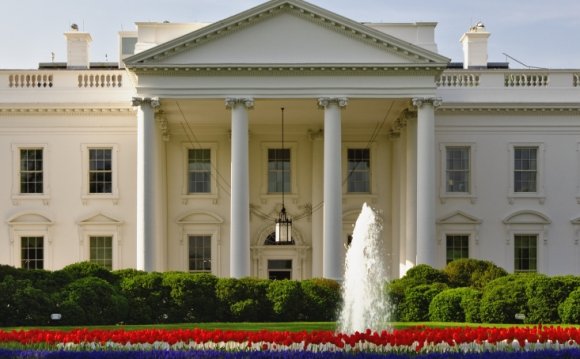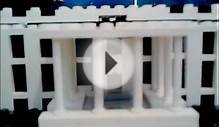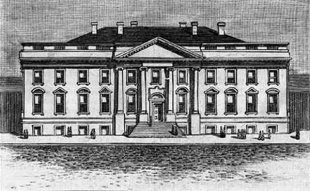
The President's ResidenceThe White House is a grand mansion in the neo-classical Federal style, with details that echo classical Greek Ionic architecture. James Hoban's original design was modeled after the Leinster House in Dublin, Ireland and did not include the north and south porticos. The presidential mansion is situated on the angled Pennsylvania Avenue at the 1600 block, down the street from the Capitol building, and so is given the address 1600 Pennsylvania Avenue NW, Washington, DC. Residence Construction: 1792-1800
The White House construction began in 1792. John Adams became the first president to take residence in the building on November 1, 1800. It was a grand mansion in the neo-classical federal style, with details that echo classical Greek Ionic architecture. James Hoban's original design was modeled after the Leinster House in Dublin, Ireland and did not include the north and south porticos. Still, when it was complete, the President's house was the largest residence in the United States and would remain so until the 1860s. Jeffersonian Enhancements: 1801-1809The house that Thomas Jefferson entered in March of 1801 was still unfinished. Among his first acts was to have proper water closets (early toilets) built in the upper floor to replace the outdoor privy. He created a wilderness museum in the Entrance Hall, with mounted animals and Indian artifacts. He housed his private secretary in canvas-walled chambers in the south end of the unfinished East Room. He also had a revolving cabinet built in the Public Dining Room (today's Family Dining Room) similar to ones he had in Monticello. And he built pavilions on the east and west sides for servants and stables. Madison Reconstruction: 1814-1817In 1814, during the War of 1812, much of Washington, DC, was burned down by British troops and the White House was gutted, leaving only the exterior walls standing. Despite architect Latrobe's suggestions for changes, President James Madison pledged to restore the White House just as it was. Original architect James Hoban returned to supervise the reconstruction, and few architectural changes were made when restoration was completed in 1817 under President James Monroe, who furnished the house in fashionable style.
Architectural Improvements & War: 1825-1865The front and rear porticos were added to the White House 1825 and 1830, when Thomas Jefferson commissioned Benjamin Henry Latrobe to make architectural changes to the mansion (Latrobe had done proposals that included porticos as early as 1807). Additional changes followed in 1835, when running water and central heating were installed. President Johnson's daughter redecorated the house in bold geometric designs. And large glass conservatories were constructed on either side of the mansion, providing flowers and plants of all sorts, as well as a pleasant place to talk or read a book. Victorian Ornamentation: 1873-1901US Grant converted the White House to a high Victorian style, although his choices were openly mocked by some. This was further enhanced by Louis Tiffany with Tiffany glass windows, gaslight fixtures, and other ornamentation in the 1890s. Electric lights replaced gaslights starting in 1891. The Expansion that Never Was: 1889-1901Mrs. Caroline Scott Harrison proposed a major expansion of the White House in 1889 which was revived in 1900 by Colonel Bingham. Wings of more or less the same size as the Residence mansion were proposed for the east and west sides, turned sideways to face the East and West Executive Drives, and a new conservatory was proposed to connect them on their south sides. Although the plans were rejected, the idea of building east and west wings was taken up by Theodore Roosevelt. TR Restoration: 1902-1904In 1902, Theodore Roosevelt embarked on an extensive remodeling of the Residence. Plans had been in the works for years to build a new White House or expand the original. TR trod lightly, though, and merely removed the Victorian decor accumulated over the previous thirty years and returned the White House to its Federal-period roots with some Georgian elements. Building the first West Wing (and East Wing) allowed him to move the presidential staff out of the family rooms on the second floor. Roof Expansions: 1917 and 1927The Wilsons renovated part of the attic in 1917 to include a painting room and guest rooms, but it was never adequate. |
RELATED VIDEO












